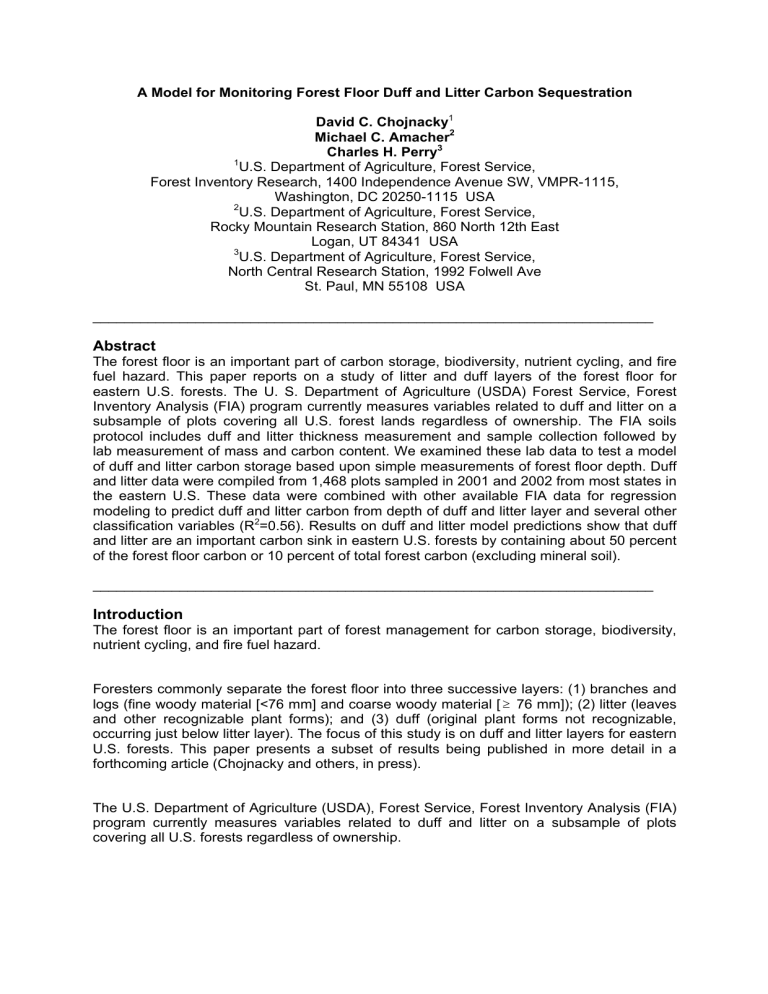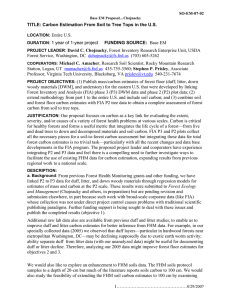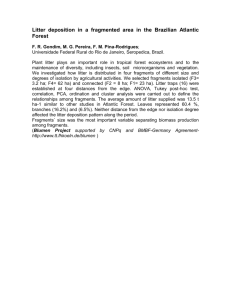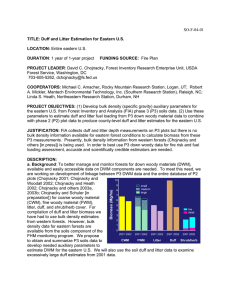A Model for Monitoring Forest Floor Duff and Litter Carbon... David C. Chojnacky Michael C. Amacher

A Model for Monitoring Forest Floor Duff and Litter Carbon Sequestration
David C. Chojnacky
1
Michael C. Amacher
2
Charles H. Perry
3
1
U.S. Department of Agriculture, Forest Service,
Forest Inventory Research, 1400 Independence Avenue SW, VMPR-1115,
Washington, DC 20250-1115 USA
2
U.S. Department of Agriculture, Forest Service,
Rocky Mountain Research Station, 860 North 12th East
Logan, UT 84341 USA
3
U.S. Department of Agriculture, Forest Service,
North Central Research Station, 1992 Folwell Ave
St. Paul, MN 55108 USA
_______________________________________________________________________
Abstract
The forest floor is an important part of carbon storage, biodiversity, nutrient cycling, and fire fuel hazard. This paper reports on a study of litter and duff layers of the forest floor for eastern U.S. forests. The U. S. Department of Agriculture (USDA) Forest Service, Forest
Inventory Analysis (FIA) program currently measures variables related to duff and litter on a subsample of plots covering all U.S. forest lands regardless of ownership. The FIA soils protocol includes duff and litter thickness measurement and sample collection followed by lab measurement of mass and carbon content. We examined these lab data to test a model of duff and litter carbon storage based upon simple measurements of forest floor depth. Duff and litter data were compiled from 1,468 plots sampled in 2001 and 2002 from most states in the eastern U.S. These data were combined with other available FIA data for regression modeling to predict duff and litter carbon from depth of duff and litter layer and several other classification variables (R
2
=0.56). Results on duff and litter model predictions show that duff and litter are an important carbon sink in eastern U.S. forests by containing about 50 percent of the forest floor carbon or 10 percent of total forest carbon (excluding mineral soil).
_______________________________________________________________________
Introduction
The forest floor is an important part of forest management for carbon storage, biodiversity, nutrient cycling, and fire fuel hazard.
Foresters commonly separate the forest floor into three successive layers: (1) branches and logs (fine woody material [<76 mm] and coarse woody material [ 76 mm]); (2) litter (leaves and other recognizable plant forms); and (3) duff (original plant forms not recognizable, occurring just below litter layer). The focus of this study is on duff and litter layers for eastern
U.S. forests. This paper presents a subset of results being published in more detail in a forthcoming article (Chojnacky and others, in press).
The U.S. Department of Agriculture (USDA), Forest Service, Forest Inventory Analysis (FIA) program currently measures variables related to duff and litter on a subsample of plots covering all U.S. forests regardless of ownership.
We used FIA field and lab soils data (FIA 2004; O’Neill and others 2005) to model duff and litter carbon storage based on available FIA and auxiliary climate variables. The objective is to provide a simple technique for estimating forest floor carbon.
A Model for Monitoring the Forest Floor for Duff and Litter Carbon
Data Collection and Methodology
The 3rd phase (P3) of the FIA inventory includes soil property and other forest health attribute measurements (fig. 1).
This phase subsamples about 1/16 of
FIA’s 120,000 forest plots in its 2 nd phase (P2), which are monitored nationwide on a 7- to 10-year cycle (FIA
2006). At each plot, generally three duff and litter samples were collected; both layers were combined during collection.
Before collecting samples, duff and litter depths were measured separately at four points within the sample frame (fig.
1 inset). Duff and litter samples were then sent to labs where dry weight and carbon content were determined for both layers combined .
North Central
South
Northeast
Plots
0
3 - 12
13 - 36
36 - 65
65 - 105
202
Data were summarized for each plot, and we used:
9 Regression analysis to predict carbon content (in Mg/ha) from available predictor variables.
9 Graphical analysis for selecting
9
9 variables and devising model form.
Carbon
1971) as the base model equation to allow considerable flexibility in fitting data. for the dependent variable because it was better correlated with layer depth measures than was mass.
Hoerl’s function (Daniel and Wood
Figure 1—State distribution of 1,468 soil sample sites where duff and litter materials were collected by FIA in
2001 and 2002 in three regions. Not all states were sampled, and some locations (such as Allegheny
National Forest in Pennsylvania) were sampled more intensively. Litter and duff were collected in the field by hand-scraping material within a 30.5-cm-diameter sampling frame and bagging it for later weight and carbon measurement in the lab
Model results
We developed two models (equations 1 & 2):
(1) The best possible model from available data was a function of duff depth, duff and litter depth, dew point temperature, latitude, longitude, and ecoregion dummy variables.
(2) A scaled-back version compatible for application to current FIA P2 inventory plots was a function of conifer/hardwood forest type, wet days, relative humidity, longitude, and ecoregion dummy variables.
The primary feature of the “best” model is that it predicts duff and litter carbon simply by measuring depths at some points along transects and determining the other variables from auxiliary information based on geographic coordinates of the sample location. A log transformation was used to explain 56 percent of the variation ( R
2
=0.56, in log units ) based on data from 1,410 plots. By using depth measurements, this model is sensitive to local site variation and disturbance.
The “scaled-back” model (for FIA use) was necessary for predicting duff and litter carbon without duff and litter depth measurements because these are unavailable from FIA’s P2 data for wide-scale model application. Other than forest type, this model was based on geographic or climatic variables. It explained some regional variation but was insensitive to local site-specific variation ( R
2
=22, n=1,405).
Best : Y
=
FIA : Y
=
Exp
⎣
⎢
⎡ 5.122
51.752
+
+
0.8443
1.0529
X
3 ln
+
X
1
−
−
0.0277
0.0861
0.0943
X
5
−
X
X
1
8
+
+
0.6891
0.3010
0.5849
X
6
+
X
X
2
9
−
+
0.1002
0.1548
0.1266
X
7
−
X
X
4
11
+
+
0.0119
3.5551
0.2374
X
10
−
2.5079
X
12
−
2.1734
X
13
X
7
X
14
⎥
⎤
⎦
(1)
(2) where :
X
X
X
X
Y
1
2
3
4
= carbon of duff and litter (Mg/ha)
= duff and littter depth (cm)
= duff depth (cm) divided by duff and litter depth (X
1
)
=
⎧
⎩
1
0 if FIA plot otherwise is conifer forest type
= dew point temperatur e ( o
C)
X
X
X
X
5
6
7
8
= average number of rain or snow " wet days" (No./year)
= average annual relative humidity (%)
= longitude of county center assigned to all FIA plots in that county (decimal degrees)
= latitude of county center assigned to all FIA plots in that county (decimal degrees)
X
X
9
10
=
1 if FIA plot in Laurentian Mixed Forest Province (212)
0 otherwise
=
⎧
⎨
1
0 if FIA plot in Oceanic Eastern Broadleaf otherwise
Ecological Province (221)
X
11
X
12
=
⎧
⎩
1
0 if FIA plot in Mountainou s Appalachi an Mixed Forest otherwise
Ecological Province (M221)
=
1 if FIA plot in Continenta l Eastern Broadleaf Ecological Province (222)
0 otherwise
X
X
13
14
=
⎧
⎨
1
0 if FIA plot in Southeaste rn Mixed otherwise
Forest Ecological Province (231)
=
⎧
⎩
1
0 if FIA plot otherwise in Outer Coastal Plain Mixed Forest Ecological Province (232)
Both models estimated duff and litter combined because that is how FIA collects these data for lab processing. However, had duff and litter been kept separate, more precise models probably could have been developed. To test this, in late summer 2005 we collected additional separate duff and litter samples (using FIA protocol) at 57 sites in North Carolina,
Virginia, and West Virginia covering an elevation gradient that included pine plantations, hardwood, and conifer forests. These samples are awaiting lab processing for carbon determination.
Discussion
The best model could not be applied to FIA data but a simulation showed how geography and duff and litter depth affect predictions (fig. 2).
Differences between states in fig. 2 are a little difficult to interpret because the duff and litter (on the x and y axes) are combined due to
30
25
20
15
10
Maine
Missouri
Florida
FIA protocol. However, the best model includes a ratio variable of duff-to-litter to somewhat account for the effect of combining duff with
5
0
0 10 20 30 40 50 litter. Maine—for example—has the most duff of any state for a given
Duff & Litter Depth (cm) depth value on the x-axis. Therefore, the much greater material density Figure 2—Carbon simulation from the “best” model illustrating of duff compared to litter accounts for Maine’s high carbon estimates.
When the data from the 2005 the importance of duff and litter depth and geographic variables. Maine shows much greater carbon for given duff and litter depth because its forest floor is over 60 percent duff, whereas the forest floor in Missouri and Florida forests is separated duff and litter sampling become available, they will be predominately litter. More carbon can be stored in duff than in an equal depth of litter because duff has a much greater quite useful for further interpretation of these results as in fig. 2. Also, these data will be used to devise a ratio model for separating duff from litter.
The scaled-back model for FIA application to phase 2 was applied to 99,274 plots for estimating mean duff and litter in each county for eastern U.S. forests. A map of results shows that carbon accumulation on the forest floor follows a climate gradient, with a decrease from northeast to southwest (fig. 3).
On average, duff and litter account for 10 percent of forest carbon, including trees, down dead material, and understory. However, excluding standing trees, duff and littler account for
50 percent of the carbon in the dead forest floor material and understory vegetation.
Duff & Litter
Finally, duff and litter data were examined for a conversion of carbon to mass. On average, duff and litter mass was found to have 35 percent carbon for the 1,468 samples. The samples were more or less normally distributed with median of 36.4 percent. The 95 percent confidence intervals for the mean ranged from
34.6 to 35.6 percent.
Carbon
(Mg/ha)
5.5 - 19
4.2 - 5.5
3.3 - 4.2
1.7 - 3.3
missing
Figure 3—Distribution of duff and litter carbon estimated from a “scaled-back” FIA model for each
P2-plot shown as a mean for each county. The four colors represent the quartiles of county means; in other words, this is a statistical map for only the forested portion of each county
Summary and conclusions o Combined duff and litter carbon can be modeled from simple forest floor depth measurements using FIA field and lab P3 soils data and auxiliary climate and geographic variables. o The best model ( R
2
=0.56) is a function of duff and litter depth measurements and geographic coordinates of the county center were the plot is located. The geographic coordinates are also used to obtain auxiliary variables for dew point temperature and 0,1 dummy variables based on which ecoregion the plots is in. o A second model ( R
2
=0.22) was also developed for ready use with FIA P2 data (which does not include duff and litter depth measurements) and is a function of forest type and auxiliary climate and ecoregion variables. o For best results, FIA ought to consider including duff and litter depth measurements on all P2 plots (for using the “best possible” model) and consider collecting and processing the duff and litter layers separately in P3 plots (to allow for even better model development). o Because duff and litter have such different material densities, separate duff and litter samples were collected in 2005 and will be examined (when processed) for further improvement in duff and litter modeling. o Duff and litter layers are an important carbon sink in eastern U.S. forests because they contain about 50 percent of forest floor carbon or 10 percent of total forest carbon
(excluding mineral soil).
Reference
Chojnacky, D.C.; Myers, J.M.; Amacher M.C.; Gavazzi, M.J.; and McNulty, S.G. (in preparation for Forest Ecology and Management ) Estimating forest floor mass and carbon in eastern U. S. Forests.
Daniel, C.; Wood, F.S. (1971) Fitting Equations to Data. New York: John Wiley and Sons.
458 p.
Forest Inventory and Analysis [FIA]. (2004) 2.0 Phase 3 field guide – soil measurements and sampling, March 2004.
USDA Forest Service, FIA program. http://fia.fs.fed.us/library/field-guides-methods-proc/docs/p3_2-0_sec11_3_04.pdf
[Jan. 10,
2006].
Forest Inventory and Analysis [FIA]. (2006) USDA Forest Service, FIA program homepage. http://fia.fs.fed.us/ [Jan. 10, 2006].
O’Neill, K.P.; Amacher M.C.; and Perry, C.H. 2005. Soils as an indicatory of forest health: a guide to the collection, analysis, and interpretation of soil indicator data in the Forest
Inventory and Analysis program. Gen. Tech. Rep. NC-258. St. Paul, MN: USDA Forest
Service, North Central Research Station. 53 p.





